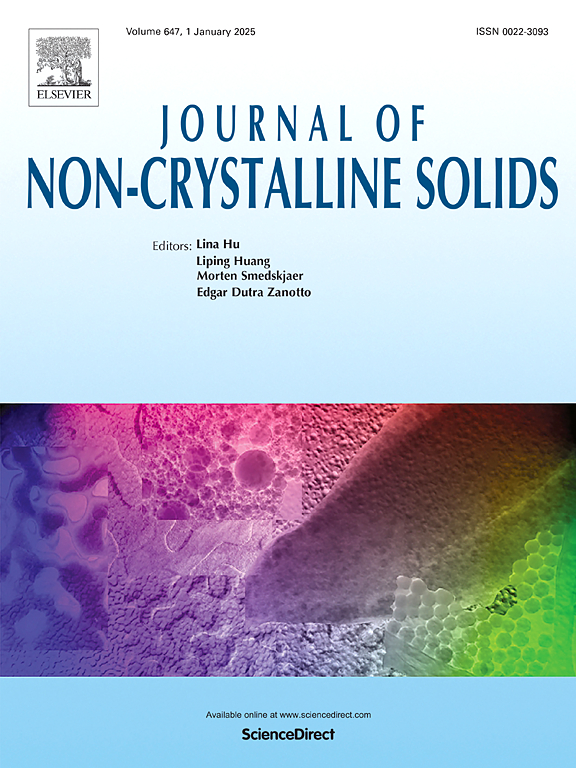Toward a better understanding of the mechanisms that control dissolution of calcium aluminosilicate glass
IF 3.5
3区 材料科学
Q1 MATERIALS SCIENCE, CERAMICS
引用次数: 0
Abstract
We investigated the dissolution behaviour of calcium alumininosilicate (CAS) glass at different pH values and temperature in batch and flow-through experiments. The temperature dependence of the dissolution rate over a wide pH range was measured under flow-through conditions at ambient temperature and at 50 and 75 °C, using crushed CAS glass powder (25 µm < x < 63 µm). CAS powder and single glass chips were exposed to deionised water (initial pH 5.6), an acetate buffer (pH 4.4–4.5) and a 0.1 M NaOH (pH 13) solution for 28 and 150 days in static batch mode at ambient temperature. Flow-through dissolution experiments demonstrated close to congruent dissolution of CAS powder with a minimum dissolution rate at neutral pH and an insignificant temperature dependence. Batch dissolution experiments resulted in slower initial dissolution rates than in flow-through tests, a dissolution rate drop over time, and incongruent CAS dissolution, with specific behaviour highly dependent on solid surface area-to-solution volume (S/V) and pH. Monitoring of the microstructural changes of CAS chips showed that CAS developed a complex calcium depleted layer in slightly acidic batch dissolution media. The thickness of this layer ranged from a few nanometres to several micrometres depending on S/V. At neutral pH, the thickness of the Ca depleted layer was only a few nanometres and Al enrichment (adsorption or secondary phase) of the top glass chip surface was observed. Samples leached in 0.1 M NaOH solution showed formation of secondary phases with various morphologies and stoichiometries, depending on initial S/V. The small size (≤ 1 µm) of these secondary phases made it difficult to identify them. The results highlight the complexity of CAS glass dissolution, which can involve congruent dissolution, leached layer formation or dissolution-precipitation mechanisms, depending on pH, temperature, and S/V.
为了更好地了解控制铝硅酸盐玻璃钙溶解的机制
本文研究了硅酸铝钙(CAS)玻璃在不同pH值和温度下的溶解行为。采用破碎的CAS玻璃粉(25µm <;x & lt;63µm)。将CAS粉末和单晶片分别暴露于去离子水(初始pH 5.6)、醋酸缓冲液(pH 4.4-4.5)和0.1 M NaOH (pH 13)溶液中,在常温下静态批处理28和150天。流动溶解实验表明,在中性pH下,CAS粉末的溶解速率最小,与温度的关系不明显,接近全等溶解。批溶实验的结果表明,初始溶解速率比流过试验慢,溶解速率随时间下降,并且CAS溶解不一致,具体行为高度依赖于固体表面积与溶液体积(S/V)和ph。对CAS芯片微结构变化的监测表明,CAS在微酸性批溶介质中形成了复杂的缺钙层。根据S/V的不同,该层的厚度从几纳米到几微米不等。在中性pH下,Ca贫层的厚度仅为几纳米,并且观察到顶部玻璃屑表面的Al富集(吸附或二次相)。样品在0.1 M NaOH溶液中浸出,根据初始S/V的不同,形成了具有不同形态和化学计量学的二次相。这些次级相的尺寸较小(≤1µm),使得它们难以识别。结果强调了CAS玻璃溶解的复杂性,根据pH、温度和S/V的不同,可能涉及全等溶解、浸出层形成或溶解-沉淀机制。
本文章由计算机程序翻译,如有差异,请以英文原文为准。
求助全文
约1分钟内获得全文
求助全文
来源期刊

Journal of Non-crystalline Solids
工程技术-材料科学:硅酸盐
CiteScore
6.50
自引率
11.40%
发文量
576
审稿时长
35 days
期刊介绍:
The Journal of Non-Crystalline Solids publishes review articles, research papers, and Letters to the Editor on amorphous and glassy materials, including inorganic, organic, polymeric, hybrid and metallic systems. Papers on partially glassy materials, such as glass-ceramics and glass-matrix composites, and papers involving the liquid state are also included in so far as the properties of the liquid are relevant for the formation of the solid.
In all cases the papers must demonstrate both novelty and importance to the field, by way of significant advances in understanding or application of non-crystalline solids; in the case of Letters, a compelling case must also be made for expedited handling.
 求助内容:
求助内容: 应助结果提醒方式:
应助结果提醒方式:


